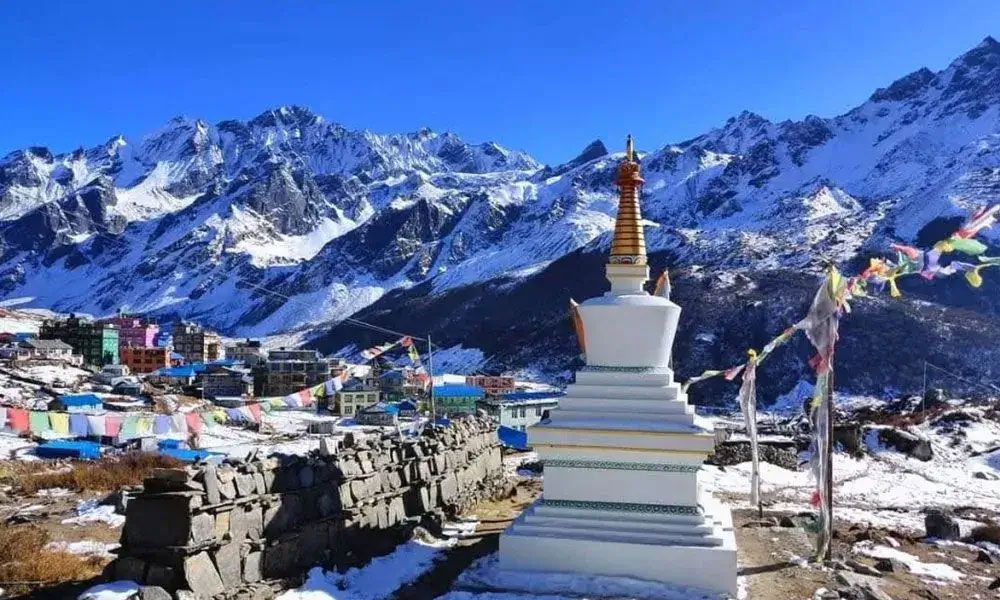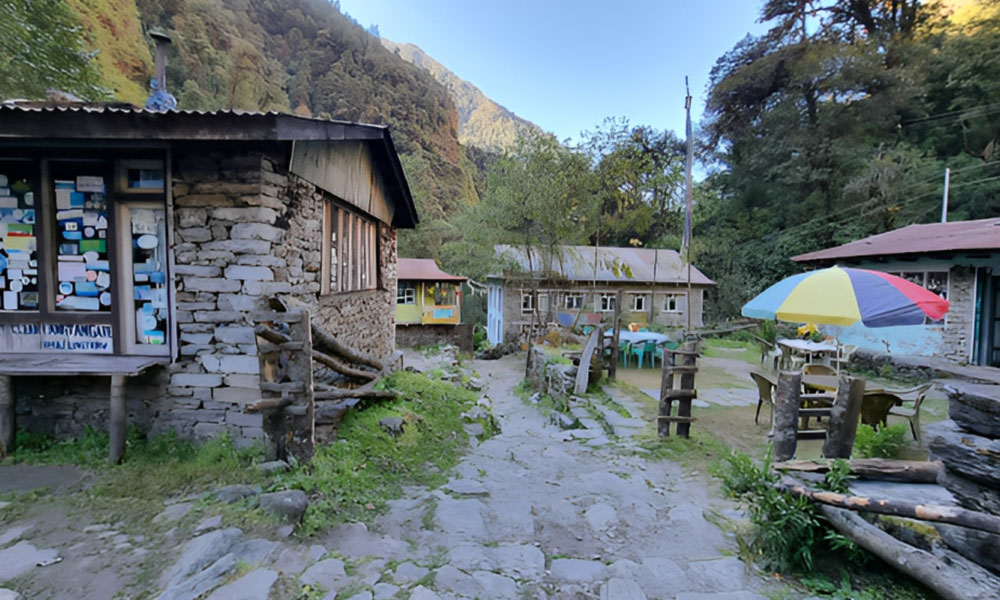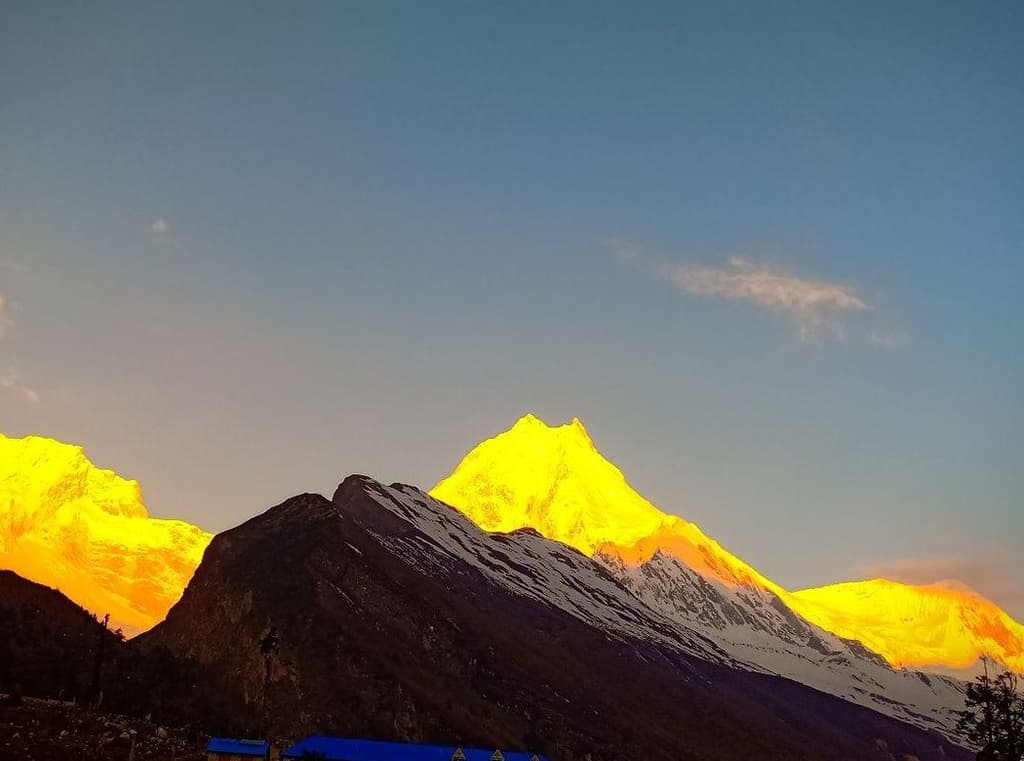Langtang Valley trek is an excellent trek. It mainly suits hikers who are short on time or are nervous about hiking on longer and high-altitude treks in the Himalayas. Despite the Langtang Valley trek being shorter by only eight days, the trekker still gets all the best parts of the Himalayan trekking. Similarly, from enjoying the glaciers and snow-capped mountains' beauty to the endangered wildlife and unique culture, eight days of Langtang Valley Trek offers a complete package.
This short journey to the Langtang Valley offers the nearest vantage point to the snow-covered peaks from Kathmandu. The beginning of Langtang Valley unfolds a little to the north of Kathmandu, near the Tibetan border. We will reach Langtang village, following the beautiful Tamang villages, terraced fields, and lush green forests.
The valley provides stunning Himalayan panoramas, dominated by the area's highest peak Langtang Lirung (7246m). This is an excellent introduction to the Nepalese Himalayas and trekking in Nepal as it falls among the most beautiful scenery here. We stretch our journey from Langtang Valley to high-elevated villages and places like Kyanjin Gompa, Kyanjin Ri, or Tesergo Ri.
This is just a rough figure as there are many other activities that you can get involved in just eight days with this Langtang Valley trek. Let's explore the eight-day Langtang Valley trek in detail below.
How to Reach Langtang Valley?

Langtang Valley is just 51 km from Kathmandu in aerial terms, i.e., via helicopter. Whereas by land route, the trailhead of Langtang Valley trek is 115 km far from Kathmandu.
To reach the trailhead of the trek, Syabrubesi, you will be taking a 7-8 hour long drive from Kathmandu. The road leading to the trailhead climbs high over ridges and provides the stunning panoramas of the Annapurna ranges in the west and Ganesh Himal Manaslu ahead. Some parts of the driving route are tarred, and some are grave, so you can expect a bumpy ride.
There are generally two ways of getting to the trailhead, Syabrubesi of Langtang Valley- private jeeps and via local bus.
By Local Bus- Traveling by local bus to the trailhead is the cheapest for budget travelers. Local buses from Kathmandu depart every morning from Gongabu Bus Park or Macchha Pokhari. The local bus generally gets off from Kathmandu at 6.30 am- 8 am and reaches Syabrubsi after a 7-8 hour drive at around 4 pm.
By Private Vehicle- Private jeeps are more comfortable, luxurious, and less crowded than local buses. This option suits travelers who do not like traveling in the local buses. Hiring a private jeep may be more costly than a public one, but it's arguably the best choice to reach the trailhead of the Langtang trek. Unlike the local buses with crowds, private jeeps are faster and make only a few stops enroute.
Trek Difficulty
Langtang Valley lies just 19 miles north of Kathmandu Valley. This destination in the Himalayas is also near the Tibetan border. Located closer to the capital city, these eight days Langtang Valley trek is easy yet wild and a bit challenging. With this in mind, 8 days Langtang Valley trek is considered a moderately difficult trek. The trekking days are indeed short as it can be completed in 8 days, but the highest elevation the trek reaches is Kyanjin Gompa (3830 m) or Kyanjin Ri (4400 m)/ Tesergo Ri (4984 m).
Kyanjin Gompa (3830 m) is the highest elevation you will reach if you choose not to trek to Kyanjin Ri or Tsergo Ri. Similarly, you will also be sping a night in Kyanjin Gompa, which increases the chance of getting altitude sickness among the trekkers. Among 8 days, the trekking duration is 7 days, where you will have to hike for about 6-7 hours daily. Sometimes, you may have to hike more or less than the average some days.
The trail of 8 days Langtang Valley trek sees many ups and downs. The trek routes ascend quickly, often gaining over 1000m in elevation within just a few days. These ascend days from the trailhead will be tiring, requiring the body to adjust to the sudden change in altitude quickly. Therefore, eight days Langtang Valley trek is easy, but it should not be taken lightly for beginners.
Best Season for Langtang Trek

The Langtang Valley experiences different weather conditions in spring, autumn, monsoon, and winter. Based on the favorable weather, temperature, and trek views, spring and autumn are the best months for 8 day Langtang Valley trek.
Spring Season
Langtang Valley trek takes you to the central Himalayan region. Therefore, these parts of the Himalayas in the spring season experience cool weather providing vibrant views. It is the same season where the rhododendron and wildflowers blooms in shades of pink, white, and red along the trails.
The daytime temple of the valley hovea is around 10 to 22 degrees Celsius in spring. Similarly, the sikes are clearer with minimal changes of cloud. And the views from the Tserko Ri and Kyanjin Ri are all worth the challenging trek.
Autumn Season
The autumn season, from mid-September to November, is another best time to visit Langtang. The season is also favorable, characterized by its warm, sunny, and shorter days. This season provides fantastic views of Langtang and other ranges from vantage points. Also, the season witnessed the biggest festival, i.e., Dashain and Tihar. Therefore, exploring and learning about people's culture and traditions is a great time. The daytime hiking will be easy, with favorable temperatures hovering around 10 to 20 degrees Celsius.
Off Seasons-
The winter months start in December and last till February. The season brings out the colder and harsh nights and days with it. The region experiences harsh weather where temperatures can drop to -3 degrees Celsius. The winter season can also consider one of the best times to trek if you are into the Himalayas views. But trekkers may carry heavy clothing and crampons to cross the snow trails.
Summer comes with the monsoon season from June to Mid-September. It is the time of the year when the region experiences hot and humid weather conditions. This might not be a favorable month as the ves may get obstructed, and the trails may get slippery.
Langtang Trek Accommodations

8 days Langtang Valley trek is a tea house trekking. This means you will use a tea house for your accommodations in different places for 8 days. The locals run these tea houses and only provide meals and lodging with very basic facilities.
After arriving in Kathmandu, you can stay at hotels with basic and luxurious facilities. But as you drive to Syabrubesi and trek higher, you will spend the night at the houses run by the local families there.
Tea houses are found all over the trails around the Langtang Valley. But the region's teahouses have completely changed after the 2015's destructive earthquake. Moreover, the tea houses we find n along the trails do not match the lifestyles of the locals. In fact, they are constructed per the interests and prefectures of the tourists visiting the valley.
The basic tea houses cost around $5-$7 for a night and come with a bedroom and a shared bathroom. If a basic tea house is not your cup of tea, you can choose teahouses worth $12-$20 a night, with amenities like private bathrooms, internet services, 24/7 electricity, hot showers, etc.
Permits for Trek
The Langtang Valley trek takes place within the Langtang National Park area. It's a protected area that requires two trekking permits to enter, i.e., a Langtang National Park Entry permit and a Trekkers Information Management System (TIMS) card. These two trekking permits and the trekking guides are mandatory for 8 days of the Langtang Valley trek.
The cots rated to the permits are as follows:
- Langtang National Park permit costs around 3,000 NPR (Approx. USD 30) plus 13% VAT for foreigners and 1500 NPR (Approx. USD 15) plus 13% VAT for SAARC
- TIMS permit: Due to the solo trekking banned in Nepal, the TIMS permits, which used to cost around 1,000 NPR (Approx. USD 10), now cost 2,000 NPR (Approx. USD 20)
Both permits are a must and can be collected from the Nepal Tourism Board Office in Pradarshani Marg, Kathmandu lying, 20 minutes far from Thamel. If you cannot get the required permits in Kathmandu, you can acquire the permits on your way to Syabrubesi from the first and second checkpoints.
8 Days Langtang Valley Trek Detailed Itinerary
Day 1: Drive to Syabru Besi from Kathmandu

Syabrubesi Elevation- (1,503 m / 4,655 ft)
Distance- (122km / 75.8miles)
Driving Hours- 7/ 9hrs
The first day of the Langtang Valley trek starts with a scenic and adventurous drive. After an early breakfast in the hotel, we leave Kathmandu on a bus or jeep that takes us north along the main road. The total duration of the road trip is around 6 to 7 hours.
During the favorable season, we will see beautiful views of terraced fields, snowcapped mountains, and rivers. The road from Kathmandu takes you to Dhunche via the Nuwakot district. We will cross many landmarks like Trishuli Bazaar, Battar, Bandre, Kalikasthan, and Dhunche before finally reaching Syabrubesi. While traveling along the road at the Trishuli River's bank, we will catch the first glimpse of the Ganesh Himal, green hills, and terraces. While passing via the Dhunche, we will feel like we are heading toward the deep land. After reaching the Syabrubesi, our 1st day of the Langtang Valley will be successive.
Day 2: Trek from Syabru Besi to Lama Hotel
Lama Hotel Elevation- (2,470m / 8,103ft)
Trek Distance- 11.3km / 7miles
Trekking Hours- 6/7 hrs
After spending the night at Syabru Besi, we will prepare for the trek to Lama Hotel today. We trek from the Syabrubesi and follow the Langtang River and Bhote Kosi River route. While crossing the route, we come across beautiful terraced fields, a fertile jungle, and a pass leading us to the rural settlements adorned with bamboo and birch groves.
This pass is great for spotting rare and endangered wildlife like the red panda. The trek gradually ascends from here to Rimche (2,400m) via the Bamboo, which lies at the Langtang River bank. Following the trail further, we reach the Lama Hotel.
Day 3: Trek to Langtang Village From Lama Hotel
Langtang Valley Elevation- (3,430m/11,255ft)
Trek Distance- 14.8km / 9.1miles
Trek Hours- 6 hrs
The day begins with an early morning breakfast and sunrise views of the Himalayas. After breakfast, we leave Lama Hotel and hike alongside the river via the lush landscape. As we climb upward through dense forests from here, we will see many snowy peaks (if the weather is favorable with clear visibility). We continue to trek until the narrow river valley widens out at GhoraTabela. The GhoraTabela area, now an army check post, was once a Tibetan resettlement project running.
From here, we will register our paper permits at the check post for our trek. As we trek from Ghora Tabela, we reach Chyamki village (3,230m). We will take a short break for lunch at either Ghora Tabela or Chyamki village and continue to trek until we reach the trail with water mills, shortens, and prayer wheels. We trek past the prayers where, flags, and flowing water, leading us directly to the Langtang Valley. It's a village inhabited mainly by the Tamang people.
Day 4: Trek to Kyanjin Gompa from Langtang Village

Kyanjin Gompa Elevation- (3,865m/12,675ft)
Trek Distance- 6.8km / 4.2miles
Trek Hours- 3hrs
After a delicious breakfast and a good cup of tea/ coffee, our Langtang trek continues towards the Kyanjin Gompa today. Today's trek will be short and easy as we will only make 400m ascend from here. We will transverse via the many small plateaus, yak pastures, meadows, mani walls, and small villages. We will make a 400m ascend towards the Kyanjin Gompa, so we should trek slowly to give our bodies enough time to acclimate to the altitude.
After an hour of trekking, we will come across the prayer wheels, water mills, and sacred mounds of rocks with carved inscriptions. We cross this trail and reach Kyangjin Gompa, an ancient monastery of the Langtang region. It's a beautiful place surrounded by the Himalayas. We explore the area around the Kyanjin Gompa and admire the spectacular panoramas of the snow-capped peaks.
Kyanjin Gompa is a great place to learn and encounter many Buddhist practices. The huge main walls, prayer flags, and chortens around the monastery reflect the heritage of Buddhism. The religious scriptures and stone inscriptions are all worth visiting the ancient monastery. Trekkers can also visit the cheese factory nearby the Gompa. The factory is famous for the manufacture of pure and organic Yak cheese.
Day 5: Rest Day and Short Hike around
Kyanjin Gompa Elevation- (3,865m/12,675ft)
We have now made an exhausting long trek above 3500 meters above sea level. Therefore, we need to rest and acclimate at Kyanjin Gompa to reduce the possibility of altitude sickness. This area is beautiful, with so much to offer its visitors. And since we are at high elevations, we surely get views of the Himalayas ranges and glaciers.
We will take a full-day exploration as there is so much to do. We will explore the monastery that portrays the Buddhist religion's history and practices. We may also see the monks in the monasteries offering their prayers.
Besides, trekkers can also embrace an optional acclimatization hike to the viewpoint of TserkoRi (5,450m) or Kyanjin Ri (4400 meters). If you embark on either of these treks, then this will be the high elevation of your Langtang Valley trek. Bot hare incredible viewpoints for the peak, like Langtang Lirung and Langtang II.
Day 6: Trek from Kyanjin Gompa to Lama Hotel

Langtang Valley Elevation- (3,430m/11,255ft)
Trek Distance- (21km / 13 miles)
Trek Hours- 6 hrs
From today our descent journey begins from Kyangjin Gomba. After admiring the last glimpse of the peak standing before us with pride, we trek out of the valley.
From Kyangjin Gomba, we retrace along the same path we took to get here, passing through Langtang Village again. We pause for lunch at Ghora Tabela, where the military checkpoint records our departure. We continue to trek from here down through the dense forests near the river valley to Lama Hotel.
Day 7: Trek from Lama Hotel to Syabru Besi
Syabrubesi Elevation- (1,503 m / 4,655 ft)
Trek Distance- 11.3km / 7miles
Trek Hours- 5hrs
Today is the last day of our trekking journey. We will be heading to the trailhead of Langtang Valley, i.e., Syabrubensi, so we can drive from there to Kathmandu. The route is the same as before, where we will walk along the Langtang River and hike down the beautiful river valley. After some hours of hiking, we will reach Rimche Village first. We continue to hike from here through bamboo and birch forests.
During our hike, we will see the wonderful landscapes and a trail that crosses the Langtang and the Bhote Koshi rivers, finally leading us to the Syabrubensi. Upon reaching the Syabrubensi, we trek to the guesthouse or tea house and stay overnight.
Day 8: Drive from Syabru Besi to Kathmandu
Kathmandu Elevation- (1400m / 4,393ft)
Distance- (122km / 75.8miles)
Driving Hours- 7/9 hrs
After completing our eventful and enjoyable trek, we will sit on our vehicle, bus, or jeep for a drive to Kathmandu. The driving duration is about seven to nine hours from Syabrubensi.
We enjoy our last breakfast of the trek in Syabrubensi and take a ride back to Kathmandu. We will drive through the countryside of Dhunche Village and various settlements in Nuwakot District. It will be a scenic and adventurous drive as we will be greeted by scenic views of the Trishuli River valley once we head south of the hills. We again see the terraced meadows, farmlands, and final views of the Himalayas. After we reach Kathmandu, you will be transferred to your respective hotels.
You may also like:


